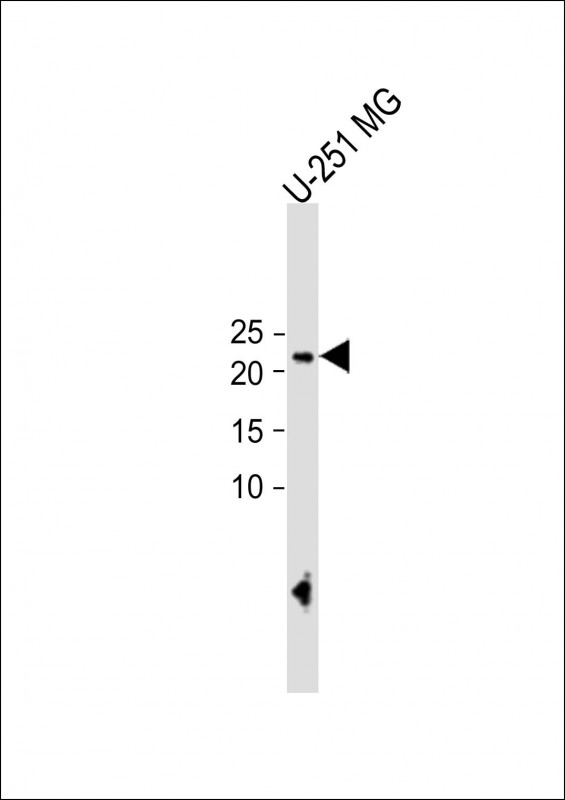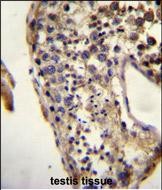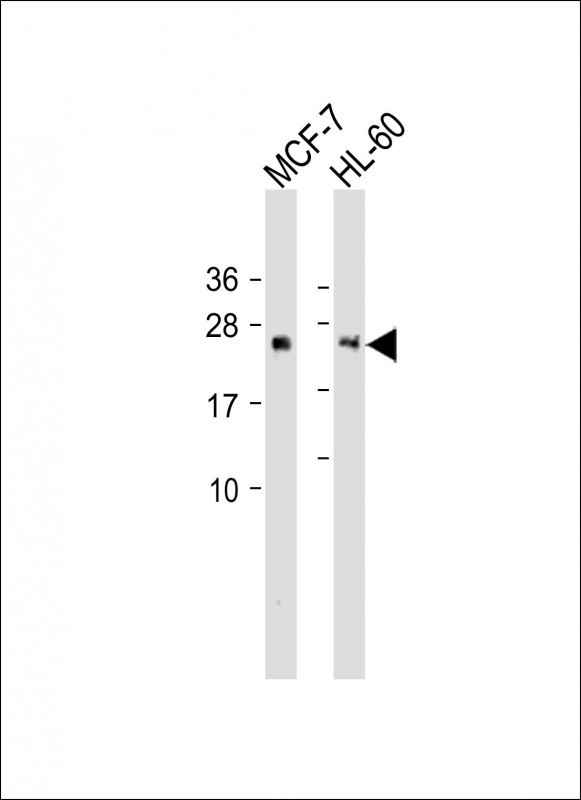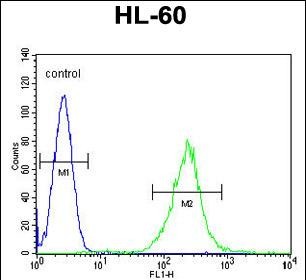ECAT1 Antibody (N-term)
Affinity Purified Rabbit Polyclonal Antibody (Pab)
- 产品详情
- 文献引用 : 2
- 实验流程
Application
| WB, IHC-P, FC, E |
|---|---|
| Primary Accession | Q587J8 |
| Other Accession | NP_001017361 |
| Reactivity | Human |
| Host | Rabbit |
| Clonality | Polyclonal |
| Isotype | Rabbit IgG |
| Calculated MW | 24306 Da |
| Antigen Region | 20-48 aa |
| Gene ID | 154288 |
|---|---|
| Other Names | KHDC3-like protein, ES cell-associated transcript 1 protein, KHDC3L, C6orf221, ECAT1 |
| Target/Specificity | This ECAT1 antibody is generated from rabbits immunized with a KLH conjugated synthetic peptide between 20-48 amino acids from the N-terminal region of human ECAT1. |
| Dilution | WB~~1:500-1:1000 IHC-P~~1:100~500 FC~~1:10~50 E~~Use at an assay dependent concentration. |
| Format | Purified polyclonal antibody supplied in PBS with 0.05% (V/V) Proclin 300. This antibody is prepared by Saturated Ammonium Sulfate (SAS) precipitation followed by dialysis against PBS. |
| Storage | Maintain refrigerated at 2-8°C for up to 2 weeks. For long term storage store at -20°C in small aliquots to prevent freeze-thaw cycles. |
| Precautions | ECAT1 Antibody (N-term) is for research use only and not for use in diagnostic or therapeutic procedures. |
| Name | KHDC3L {ECO:0000303|PubMed:31609975, ECO:0000312|HGNC:HGNC:33699} |
|---|---|
| Function | Component of the subcortical maternal complex (SCMC), a multiprotein complex that plays a key role in early embryonic development (By similarity). The SCMC complex is a structural constituent of cytoplasmic lattices, which consist in fibrous structures found in the cytoplasm of oocytes and preimplantation embryos (By similarity). They are required to store maternal proteins critical for embryonic development, such as proteins that control epigenetic reprogramming of the preimplantation embryo, and prevent their degradation or activation (By similarity). KHDC3 ensures proper spindle assembly by regulating the localization of AURKA via RHOA signaling and of PLK1 via a RHOA-independent process (By similarity). Required for the localization of MAD2L1 to kinetochores to enable spindle assembly checkpoint function (By similarity). As part of the OOEP-KHDC3 scaffold, recruits BLM and TRIM25 to DNA replication forks, thereby promoting the ubiquitination of BLM by TRIM25, enhancing BLM retainment at replication forks and therefore promoting stalled replication fork restart (By similarity). Regulates homologous recombination-mediated DNA repair via recruitment of RAD51 to sites of DNA double-strand breaks, and sustainment of PARP1 activity, which in turn modulates downstream ATM or ATR activation (PubMed:31609975). Activation of ATM or ATR in response to DNA double-strand breaks may be cell-type specific (By similarity). Its role in DNA double-strand break repair is independent of its role in restarting stalled replication forks (By similarity). Promotes neural stem cell neurogenesis and neuronal differentiation in the hippocampus (By similarity). May regulate normal development of learning, memory and anxiety (By similarity). Capable of binding RNA (By similarity). |
| Cellular Location | Cytoplasm {ECO:0000250|UniProtKB:Q9CWU5}. Cytoplasm, cell cortex. Nucleus. Mitochondrion {ECO:0000250|UniProtKB:Q9CWU5}. Cytoplasm, cytoskeleton, microtubule organizing center, centrosome {ECO:0000250|UniProtKB:Q9CWU5} Chromosome. Note=Core component of cytoplasmic lattices in oocytes (By similarity). Expressed in the subcortex of oocytes (By similarity). Located throughout the cell cortex of ovulated eggs in a complex with NLRP5 (By similarity). After fertilization, restricted to the apical cortex and excluded from regions of cell-cell contact (By similarity). Localized to centrosomes during interphase and mitosis (By similarity). Localizes to sites of DNA double-strand break repair (PubMed:31609975) {ECO:0000250|UniProtKB:Q9CWU5, ECO:0000269|PubMed:31609975} |
| Tissue Location | Expression appears to be maximal in germinal vesicle oocytes, it tails off through metaphase II oocytes and is undetectable following the completion of the oocyte to embryo transition. |
Research Areas
For Research Use Only. Not For Use In Diagnostic Procedures.

Application Protocols
Provided below are standard protocols that you may find useful for product applications.
REFERENCES
Pierre, A., et al. Genomics 90(5):583-594(2007) Mitsui, K., et al. Cell 113(5):631-642(2003)
终于等到您。ABCEPTA(百远生物)抗体产品。
点击下方“我要评价 ”按钮提交您的反馈信息,您的反馈和评价是我们最宝贵的财富之一,
我们将在1-3个工作日内处理您的反馈信息。
如有疑问,联系:0512-88856768 tech-china@abcepta.com.






















 癌症的基本特征包括细胞增殖、血管生成、迁移、凋亡逃避机制和细胞永生等。找到癌症发生过程中这些通路的关键标记物和对应的抗体用于检测至关重要。
癌症的基本特征包括细胞增殖、血管生成、迁移、凋亡逃避机制和细胞永生等。找到癌症发生过程中这些通路的关键标记物和对应的抗体用于检测至关重要。 为您推荐一个泛素化位点预测神器——泛素化分析工具,可以为您的蛋白的泛素化位点作出预测和评分。
为您推荐一个泛素化位点预测神器——泛素化分析工具,可以为您的蛋白的泛素化位点作出预测和评分。 细胞自噬受体图形绘图工具为你的蛋白的细胞受体结合位点作出预测和评分,识别结合到自噬通路中的蛋白是非常重要的,便于让我们理解自噬在正常生理、病理过程中的作用,如发育、细胞分化、神经退化性疾病、压力条件下、感染和癌症。
细胞自噬受体图形绘图工具为你的蛋白的细胞受体结合位点作出预测和评分,识别结合到自噬通路中的蛋白是非常重要的,便于让我们理解自噬在正常生理、病理过程中的作用,如发育、细胞分化、神经退化性疾病、压力条件下、感染和癌症。









